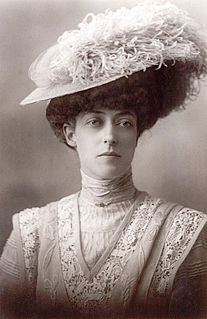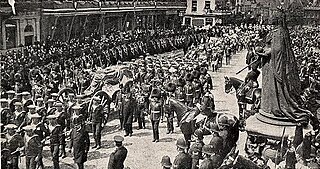
Mary, Princess Royal and Countess of Harewood was a member of the British royal family. She was the third child and only daughter of King George V and Queen Mary and was born during the reign of Queen Victoria, her great-grandmother. Mary was the paternal aunt of the current British monarch, Queen Elizabeth II. Her education started at home. World War I brought Mary out of seclusion as she launched a charity campaign to support British troops and sailors. She eventually became a nurse. Mary married Viscount Lascelles in 1922. She was an avid collector of jewellery.

Princess Mary Adelaide of Cambridge was a member of the British royal family, a granddaughter of George III, grandmother of Edward VIII and George VI and great-grandmother of Elizabeth II. She held the title of Duchess of Teck through marriage.

Princess Augusta of Cambridge was a member of the British Royal Family, a granddaughter of George III. She married into the Grand Ducal House of Mecklenburg-Strelitz and became the Grand Duchess of Mecklenburg-Strelitz.

Princess Marie Louise of Schleswig-Holstein was a granddaughter of Queen Victoria.

Louise, Princess Royal and Duchess of Fife was the third child and the eldest daughter of the British king Edward VII and Alexandra of Denmark; she was a younger sister of George V. She was the eldest granddaughter of Christian IX of Denmark. In 1905, her father gave her the title of Princess Royal, which is usually bestowed on the eldest daughter of the British monarch if there is no living holder.

Princess Maud, later Countess of Southesk, was a granddaughter of the British king Edward VII. Maud and her elder sister, Alexandra, had the distinction of being the only female-line descendants of a British sovereign officially granted both the title of Princess and the style of Highness. Despite the fact that they were not daughters of a royal duke, they were sometimes unofficially referred to with the territorial designation of Fife but in official documents, until their marriages, they were always styled Her Highness Princess Maud or Alexandra, without the territorial designation "of Fife".

Maud of Wales, was Queen of Norway as spouse of King Haakon VII. She was the youngest daughter of the British king Edward VII and Alexandra of Denmark. Maud of Wales was the first queen of Norway in over five centuries who was not also queen of Denmark or Sweden.

Princess Victoria of the United Kingdom was the fourth child and second daughter of Edward VII and Alexandra of Denmark, and the younger sister of George V.

Princess Cecilie of Greece and Denmark was the wife of Hereditary Grand Duke Georg Donatus of Hesse and third-eldest sister to Prince Philip, Duke of Edinburgh.

The funeral of King Edward VII of the United Kingdom of Great Britain and Ireland and Emperor of India occurred on Friday, 20 May 1910.

The Golden Jubilee of Queen Victoria was celebrated on 20 June 1887 on the occasion of the fiftieth anniversary of Queen Victoria's accession on 20 June 1837. It was celebrated with a banquet to which 50 European kings and princes were invited.

The wedding of Prince George, Duke of York, and Princess Mary of Teck took place on 6 July 1893 at the Chapel Royal, St. James's Palace in London.

The wedding of Princess Elizabeth and Philip Mountbatten took place on 20 November 1947 at Westminster Abbey in London. Philip had been made Duke of Edinburgh on the morning of the wedding.

The coronation of George VI and Elizabeth Bowes-Lyon as King and Queen of the United Kingdom and the Dominions of the British Commonwealth and as Emperor and Empress of India took place at Westminster Abbey, London, on 12 May 1937. George VI ascended the throne upon the abdication of his brother, Edward VIII, on 11 December 1936, three days before his 41st birthday. Edward's coronation had been planned for 12 May 1937 and it was decided to continue with his brother and sister-in-law's coronation on the same date.

The funeral of Victoria, Queen of the United Kingdom of Great Britain and Ireland, Empress of India, occurred on 2 February 1901. It was one of the largest gatherings of European royalty ever to take place.


































